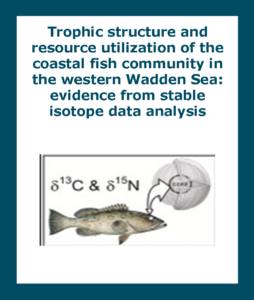We studied the trophic structure of the western Wadden Sea fish community through stable isotope analysis (δ13C and δ15N) of 1658 samples from 57 fish species collected between
2012 and 2016. Stable isotope values differed between species but did not vary between years or
seasons, and only for some species with fish size. Stable isotope values were not different between
immigrating (spring) and emigrating (autumn) fish, suggesting a similar trophic niche of the various
fish species in the coastal zone and inside the Wadden Sea. For the majority of species, average
δ13C values were within the range of −12 to −20.5‰, showing that both (marine) pelagic and
benthic primary producers were at the base of the food web. Average δ15N values varied among
species from 13−18‰, resulting in estimated trophic positions (TPs) of 2.1−5.5 with the majority
between 2.2 and 3.5. Thick-lipped grey mullet Chelon labrosus, golden grey mullet C. aurata,
greater pipefish Syngnathus acus and pilchard Sardina pilchardus had the lowest TP (2.2−2.4).
Among the common species (>10 observations), the highest TP values (3.4−3.5) were found for
twaite shad Alosa fallax, smelt Osmerus eperlanus, bull-rout Myoxocephalus scorpius, bass Di cen –
trarchus labrax and cod Gadus morhua. For all species, estimated TPs based on isotope values
were lower than those based on stomach content composition (2.0−4.7), which could be explained
by species-specific differences in trophic fractionation or by underestimation of the contribution of
smaller prey species in the stomach content analysis. The trophic niche space of benthopelagic
species was the smallest and overlapped with that of the pelagic and benthic species. In terms of
area use, trophic niche space was smaller for juvenile marine migrant species (nursery-type species)
and overlapped with that of the (near-)resident species and marine seasonal visitors. Potentially,
trophic competition is highest for the functional group of benthopelagic species and the
guild of juvenile marine migrant species (nursery-type species).
